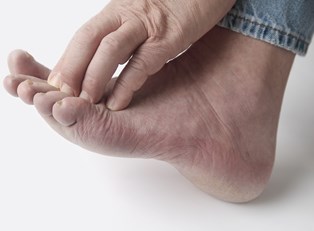Diabetic neuropathy is a common complication that affects patients with diabetes, a disease that impairs the body’s ability to regulate blood glucose levels.
Diabetic neuropathy is nerve damage that is caused by poor circulation. As diabetics struggle with controlling elevated blood sugar levels, the excess glucose, can destroy the blood vessels over time. Consequently, the vascular damage or reduced circulation can cause diabetic neuropathy, injury to the nerve fibers.
Nerve damage as a complication of your diabetes can occur in any area of the body. The four most common types of diabetic neuropathy and their corresponding symptoms are noted below:
Peripheral neuropathy
Also called sensorimotor neuropathy or symmetric neuropathy, this type is the most common form of diabetic neuropathy. Peripheral neuropathy affects the ends of your nerves at your extremities. It will often originate in the toes or on the feet and progress up the legs to the hands and arms. Symptoms characteristic of peripheral neuropathy may include:
- tingling, burning, or stabbing sensations
- numbness or loss of sensation to temperature or pain
- oversensitivity to pain and touch
- muscle cramps or weakness
- loss of balance, stumbling, and tripping
- foot joint deformities
- collapsed mid-foot
Due to the loss of sensation, there is an increased risk of foot injuries, including blisters, burns, cracking, swelling, and other sores. Ultimately, amputation may become necessary if wounds go unnoticed and become severely infected.
Autonomic neuropathy
Autonomic neuropathy commonly affects the following centrally located organs or systems:
- heart
- digestive system
- bladder
- sex organs
- sweat glands
- eyes
When the cardiovascular nerves are damaged, your heart may have difficulty regulating blood pressure and your heart rate. This may cause fainting or lightheadedness upon changing positions, such as from sitting to standing.
When the bladder is affected, urinary tract infections, incontinence, and bedwetting may become problems. Men may experience erectile disfunction and women may experience vaginal dryness and arousal difficulties when sexual organs are affected by autonomic neuropathy.
Neuropathy can impair your body’s ability to regulate temperature, and you may sweat excessively, especially at night. Sensitivity to light and difficulty focusing are a few common eye symptoms that some patients have.
Additionally, autonomic neuropathy can cause hypoglycemia unawareness. Diabetics with this condition may not experience the symptoms or warning signs of hypoglycemia (not enough sugar in the blood) such as shakiness, sweating, and heart palpitations.
Proximal Neuropathy
Similar to peripheral neuropathy, this type originates as pain in your midsection rather than in your extremities. The hips, buttocks, and legs, especially the thighs, are common areas affected by proximal neuropathy. Nerve damage is more likely to affect one side of your body more than the other. Leg weakness is a common symptom, making it difficult for patients to rise up from a sitting position without assistance. Abdominal swelling is also experienced by some patients. Proximal neuropathy is also called radiculoplexus neuropathy, diabetic amyotrophy, and femoral neuropathy.
Focal Neuropathy
Also known as mononeuropathy, focal neuropathy typically attacks specific nerves in the head, legs, or torso of older diabetics.
When nerve damage occurs in the head, patients may experience:
- blurred vision
- double vision
- difficulty focusing when light or dark changes occur
- pain behind one eye
- facial paralysis
When neuropathy occurs in the legs, symptoms may include:
- pain in the front of a thigh
- pain on the outside of the shin
- pain on the inside of a foot
Symptoms experienced in the torso region include:
- chest or abdominal pain
- lower back pain



